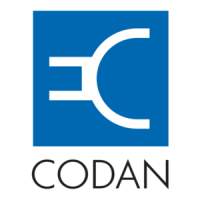NGT—Technical description (2010)
NGT Transceiver System Technical Service Manual 93
Frequency control
Reference oscillator
The reference oscillator is a Butler zero phase-shift type, and is formed by V412, V413
and associated components. There are two outputs from the reference oscillator, one via
V414, which is the local oscillator signal (LO2) for IC101 and IC103, the other via V415
to the two DDS ICs IC403 and IC404.
The reference oscillator is formed by the unbuffered inverter logic gate IC1 and Z1. The
output from IC1 is amplified by IC2 to ensure there is a square wave output. The
14.848333 MHz square wave output is then connected to the DDS ICs IC403 and IC405
via the buffer IC404.
The 14.848333 MHz square wave output is also fed to the 44.5 MHz BPF where the
third harmonic is selected and then buffered by V412 to produce the 44.545 MHz local
oscillator signal (LO2) for IC101 and IC103.
Oven controller
The crystal Z401 is in an oven that runs at approximately 70°C (158°F). The NTC
resistor R4 measures the temperature of the crystal and causes the opamp comparator
IC1 to vary the current in the heating element V2 to maintain the temperature within
±1°C (33.8°F).
The peak current of the oven is limited to 400 mA.
The crystal Z1 is in an oven that runs at approximately 70°C (158°F). The NTC resistor
R3 measures the temperature of the crystal and causes the opamp comparator IC1 to vary
the current in the heating element V2 to maintain the temperature within ±1°C (33.8°F).
The peak current of the oven is limited to 400 mA.
ALTERNATIVE TEXT
Drawing 04-03106 (sheet 3)
ALTERNATIVE TEXT
Drawings 04-03410 and 04-03378 (sheet 3)
NOTE If the PCB issue status is -06 or earlier, see drawing 04-03378 (sheet 3).
ALTERNATIVE TEXT
Drawing 04-03095
ALTERNATIVE TEXT
Drawing 04-03414

